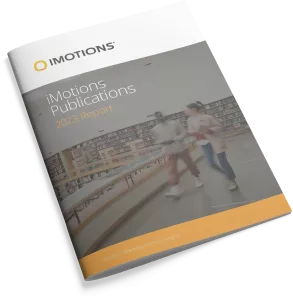-
The Influence of Price on Purchase Intentions: Comparative Study between Cognitive, Sensory, and Neurophysiological Experiments
Price is considered one of the most important attributes in consumer’s choice. On the other hand, consumer’s knowledge about price tends to be imprecise. This study aims at providing new insights analyzing consumers’ perception of retail store brand (focused on Skin Care Products) comparing with two other skin care products, a premium, and a popular […] -
DeepTake: Prediction of Driver Takeover Behavior using Multimodal Data
Automated vehicles promise a future where drivers can engage in non-driving tasks without hands on the steering wheels for a prolonged period. Nevertheless, automated vehicles may still need to occasionally hand the control back to drivers due to technology limitations and legal requirements. While some systems determine the need for driver takeover using driver context […] -
Neurocognitive processing of infants
Emerging evidence indicates that mothers and non-mothers show different neurocognitive responses to infant stimuli. This study investigated mothers’ psychophysiological, cognitive and neuronal responses to emotional infant stimuli. A total of 35 mothers with four months old infants and 18 control women without young children underwent computerized tests assessing neurocognitive processing of infant stimuli. Their eye-gazes […] -
Effort-Related Decision-Making in ADHD
ADHD is defined by behavioral symptoms that are not well characterized in relation to ADHD’s neurobiological mechanisms. This approach has limited our ability to define ADHD nosology and predict outcomes because it does not systematically examine facets of the disorder such as the inability to maintain cognitively effortful activities, as promoted in the NIMH RDoC […] -
Psychophysiological responses to takeover requests in conditionally automated driving
In SAE Level 3 automated driving, taking over control from automation raises significant safety concerns because drivers out of the vehicle control loop have difficulty negotiating takeover transitions. Existing studies on takeover transitions have focused on drivers’ behavioral responses to takeover requests (TORs). As a complement, this exploratory study aimed to examine drivers’ psychophysiological responses […] -
The Effects of Visual Stimuli on Attention in Children With Autism Spectrum Disorder: An Eye-Tracking Study
Attention is one of the fundamental elements of effective learning. The design of learning environments often consists of a blend of visual stimuli. Investigating the effect of visual stimuli types on the attention of children with autism spectrum disorder (ASD) is important for the theoretical understanding of attention. This study explores the effect of social […] -
Picking Your Brains: Where and How Neuroscience Tools Can Enhance Marketing Research
The use of neuroscience tools to study consumer behavior and the decision making process in marketing has improved our understanding of cognitive, neuronal, and emotional mechanisms related to marketing-relevant behavior. However, knowledge about neuroscience tools that are used in consumer neuroscience research is scattered. In this article, we present the results of a literature review […] -
Seeing Red? The Role of Font Color, Size, and Sale Sign Location in Retail Garden Center Displays
The goal of this study was to better understand consumers’ likelihood to buy a plant when the word “sale” was presented in red font on a white sign, with a range of font sizes, showing an equivalent discounted price in three ways (dollar amount, 25% percent off, and buy-3-get-1-free), with the sale sign location either […] -
Predicting Takeover Performance in Conditionally Automated Driving
Abstract: In conditionally automated driving, drivers decoupled from operational control of the vehicle have difficulty taking over control when requested. To address this challenge, we conducted a human-in-the-loop experiment wherein the drivers needed to take over control from an automated vehicle. We collected drivers’ physiological data and data from the driving environment, and based on […] -
Facial features and head movements obtained with a webcam correlate with performance deterioration during prolonged wakefulness
We have performed a direct comparison between facial features obtained from a webcam and vigilance-task performance during prolonged wakefulness. Prolonged wakefulness deteriorates working performance due to changes in cognition, emotion, and by delayed response. Facial features can be potentially collected everywhere using webcams located in the workplace. If this type of device can obtain relevant […]
Research Report 2024
In-depth look at the scientific landscape as powered by iMotions software, showcasing groundbreaking research and the impact of our tools in various scientific and industrial fields.

iMotions Science Resources
Looking for white papers, validation reports or research show casing iMotions Multimodal capabilities?
Share Your Research

850+ universities worldwide with an iMotions human behavior lab
73 of the top 100 highest ranked universities
710+ published research papers using iMotions
iMotions is used for some of the most interesting human behavior research studies carried out by top researchers around the world. Contact us to have your publication featured here.
The authors of these publications have used iMotions as a software tool within their research.
“Software should be cited on the same basis as any other research product such as a paper or a book; that is, authors should cite the appropriate set of software products just as they cite the appropriate set of papers” (Katz et al., 2020).
We therefore encourage you to cite the use of iMotions where appropriate.
How to cite iMotions
APA
iMotions (10), iMotions A/S, Copenhagen, Denmark, (2024).
Note: adjust the version and year where relevant.
5 Most Popular Blogs
Publications
Read publications made possible with iMotions
Blog
Get inspired and learn more from our expert content writers
Newsletter
A monthly close up of latest product and research news


